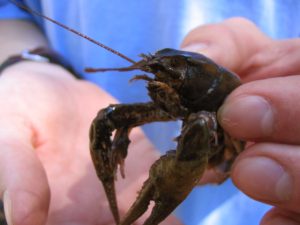By Dana Little
Hiding in the shallows around Taylor Pond you will find a small relative of the lobster called the crayfish. Typically a few inches long they hide out amongst rocks and logs. Scientists call the group of animals containing crayfish decapods (Greek term for ten-footed) due to having one pair of legs for each of the five segments of the thorax. Crayfish have a total of 20 segments to their body and each segment has an appendage. Each pair of appendages may serve a different purpose, some as mouthparts, one pair in front as legs with large pinching claws, nine smaller legs each with small pinching claws and the last few form part of the tail. Crayfish belong to the group of animals called crustaceans which includes crabs, lobsters and shrimp. In turn, crustaceans belong to the group of animals called arthropods (Greek for jointed feet) which includes insects and spiders. All arthropods have skeletons on the outside of the body (exoskeleton), a three segmented body (head, thorax and abdomen) and jointed appendages.
Dr. Karen Wilson works at the University of Southern Maine teaching limnology (the study of freshwaters) and ecology. She contacted volunteers in 2016 to trap as many crayfish as possible from lakes in Maine. She has studied the effect of alien species of crayfish in lakes and the loss of plants and animals that results. Alien crayfish have been introduced into Maine lakes when fishermen release unused bait crayfish either intentionally or unintentionally. Through her research she hopes to find the extent of invasion and the species found typically in Maine lakes. As part of her research I placed a trap for crayfish in the Taylor Pond last summer but caught no specimens. Fortunately I had a young partner, Merlin Smith, who provided me with many samples that I sent in to be identified. His technique of wading in the shallows and hand-catching produced many fine specimens! The results of Dr. Wilson’s studies have not yet been published.
Crayfish will eat almost anything organic, feeding upon both living and dead parts of animals and plants, in effect recycling otherwise wasted energy. They convert organic matter that is inedible to most animals into a delicious package. In Louisiana I have been served up trays containing dozens of “crawdads”, (their term for crayfish). One only eats the tails and I can attest to their being delicious. People locally seldom eat them, and, given the difficulty in catching them and their ability to concentrate pollutants in the water, this is probably wise. However I have watched herons and diving ducks feed on them with enthusiasm. Many animals prey on them including muskrat, mink, raccoon, pike, pickerel and bass. Over 400 different species can be identified in the US, but only seven species are native to Maine. Although they have sharp claws to protect themselves and grab prey, they will not pinch you unless handled. The largest arthropod native to our pond, the amazing crayfish is best left alone to freely roam the water.
